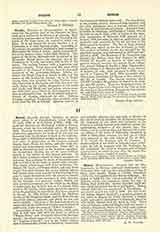

Guadix, Diocese of (GUADICENSIS), in Spain, comprises the greater part of the Province of Granada and a portion of the Province of Almeria. Acci (Accitum) was the name of the old city situated in the region of the Bastetanos, the capital of which was Baza. It is not known for certain whether it is of Phoenician or of early Spanish origin. According to Macrobius, the primitive inhabitants paid homage to Mars under the name of Neton. Julius Caesar established the Roman colony called Julia Gemella. The legend of the Seven Apostolic men preserved in the Mozarabic Missal places the episcopal see of St. Torquatus in Guadix, and names him as one of the seven. The matron Luparia built a baptistery and primitive church. From then until 303, when Felix presided at the Council of Elvira, there is no record preserved of the Accitanian bishops. Liliolus attended the Third Council of Toledo in 589, and the names of the Accitanian bishops are to be found among those who attended the other Toletan councils; Clarencius at the fourth and fifth; Justus at the sixth; Julian at the eighth; Magnarius at the ninth and tenth,. and Ricila, the last bishop whose name has come down to us before the Mohammedan invasion, at subsequent ones. In the Mozarabic period the diocese of Guadix continued to exist. Isidorus Pacensis mentions Frodoarius, who presided seven years over the See of Guadix. Quiricus assisted atthe Council of Cordoba before 839. The Almohades, in the twelfth century, destroyed this together with the other Andalusian sees; it was not restored until the time of the Catholic sovereigns. Cardinal Pedro Gonzalez de Mendoza, Archbishop of Toledo, erected the new see on May 21, 1492, in virtue of the Apostolic commission of Innocent VIII granted on August 4, 1486, restoring, by right of postliminium, the Apostolic rank possessed by the see previous to the Mohammedan invasion. The See of Baza, founded in 1306, was united to the See of Guadix in 1493. The modern cathedral, on the site occupied by the principal mosque, was commenced in 1710 and completed in 1796. The Seminary of St. Torquatus was founded by Bishop Juan Jose Fonseca in 1595; Charles IV founded an hospice in 1803, and the present hospital occupies the ancient Jesuit college. The present Bishop of Guadix is Msgr. Timotes Hernandez Mulas, b. at Morales del Vino, in the Diocese of Zamora, August 22, 1856, ordained in 1882, consecrated at Cuenca, April 26, 1908, succeeded Msgr. Maximiano Fernandez del Rincon y Soto Davila in the See of Guadix. The diocese contains about 116,000 Catholics, 62 parishes, 87 churches, 87 chapels, and 162 priests. There is a Franciscan friary at Baza, homes of the Little Sisters of the Poor at Guadix and Baza, Presentation, Franciscan, Conceptionist, and Poor Clare nuns at Guadix.
ROMON RUIZ AMADO

